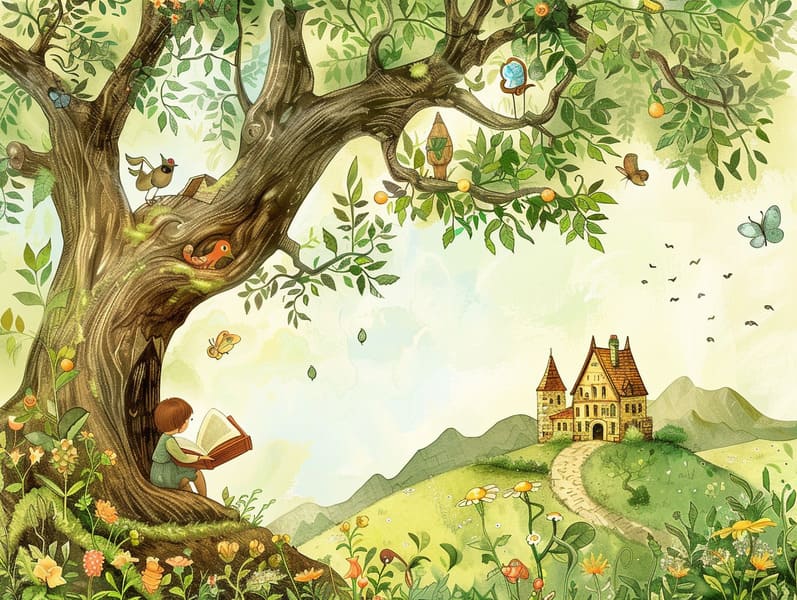
Fairy tales for kids have legendary status. These narratives have been whispered from one generation to the next well before they were ever published. They arose from a variety of backgrounds, including European traditions. They were initially narrated among older generations, often carrying themes and messages relevant to the societal norms and beliefs of the time.
The Brothers Grimm, Jacob and Wilhelm Grimm, were among the first to compile and publish many of these beloved narratives. Their published works, "Grimm's Fairy Tales," included classics like "The Little Glass Slipper," "Hansel and Grethel," and "Snow-White and Rose-Red," which have since become pillars in the world of iconic fairy tales. Similarly, the Danish author's fantastical narratives, such as "The Sea Maid," and "The Story of the Ugly Duckling," have captured hearts worldwide, establishing their place in the pantheon of treasured fairy tales.
Despite their historical roots, classic fairy tales remain as meaningful as ever, especially as children's night stories. These whimsical stories are now available in multiple formats, including gorgeously illustrated books, magical animations, and free fairy tales online.
Their persistent charm can be ascribed to several fascinating points:
Life Lessons: Traditional fairy tales often offer important moral lessons. Narratives like "The Tale of the Boy Who Cried Wolf" teach the importance of sincerity, while "The Tortoise and the Hare" show the benefits of steadfastness and unpretentiousness. These tales offer little ones clear distinctions between right and wrong, molding their moral compass in a soft yet significant way.
Empathy and Awareness: Classic fairy tales frequently include individuals facing tests and troubles, provoking young readers to identify with their struggles and rally behind their triumphs. For instance, "Beauty and Her Beast" demonstrates the merit of looking deeper to understand the inner self of a person, cultivating compassion and perception.
Cultural Appreciation: Many classic fairy tales are deeply embedded in the cultural contexts from which they emerged. Learning from these narratives can provide delightful insights into different societies, promoting a sense of cultural understanding and knowledge.
Creativity and Fantasy: The fantastical elements in classic fairy tales—magical spells—inspire children’s dreams. These narratives guide readers to mythical realms, promoting imaginative thinking and a sense of wonder that stays a lifetime.
Traditional fairy tales are not only charming but also enlightening. They work as mesmerizing tools in strengthening various intellectual and emotional capacities in young readers. When classic fairy tales are voiced, they foster linguistic abilities by offering new vocabulary and sophisticated sentence structures. website This practice also advances hearing abilities and attention span, as the young listen intently, excited to see what happens next.
Furthermore, contemplating the themes and characters of ancient fairy tales can nurture logical thinking and thinking skills. Children are taught to find patterns, make predictions, and realize cause and effect. These contemplations also facilitate young readers speak out their thoughts and feelings, advancing their emotional intelligence.
In today’s digital era, the availability of online fairy tales has made these stories more obtainable than ever. Web platforms and web apps give broad selections of popular fairy tales that can be experienced or listened through anytime, anywhere. Fairy tales spoken are particularly sought after, extending an fun way for young ones to immerse in these delightful tales. Spoken stories and read-to-me videos transport characters and settings to life, often joined by enchanting music and instrumentals that augment the storytelling journey.
The lasting appeal of ancient fairy tales lies in their ability to adjust to new eras while preserving their central messages. Contemporary takes of these narratives often incorporate more diverse characters and modern settings, making them relevant to today’s audience. However, the key lessons of boldness, kindheartedness, and truth remain unchanged, continuing to reach young readers of all ages.
Traditional fairy tales also offer a sense of ease and comprehensibility. They feature a structured narrative with a recognizable beginning, middle, and end, often ending with the termination of conflicts and the triumph of morality over immorality. This consistency can be consoling for young readers, presenting a sense of security in an dynamic world.
Old fairy tales continue to charm and inform new generations, maintaining their beauty and impact in modern society. As children's night stories, they afford a perfect blend of fascination and comprehension, promoting moral values, empathy, and creativity. The proliferation of web-based fairy tales and the sought after status of fairy tales told out loud guarantee that these old fairy tales remain acquirable to new generations.
By holding onto and broadcasting these fairy tales, we continue to acknowledge the rich tapestry of legends and cultural heritage. Whether you are browsing a vividly illustrated book, discovering a digital library, or listening to an narrated book, the wonder of classic fairy tales is always within reach. These tales highlight of the undying presence of fairy tales and its ability to unite us across epochs and places.
No matter if you are viewing a richly illustrated book, perusing a web-based library, or hearing an spoken story, the appeal of ancient fairy tales is always within reach.
These tales demonstrate of the continued impact of narratives and its ability to gather us across epochs and places, forging a link that fascinates and enlightens alike.